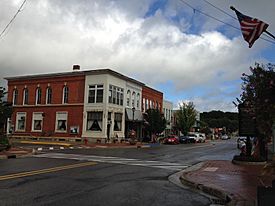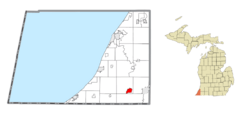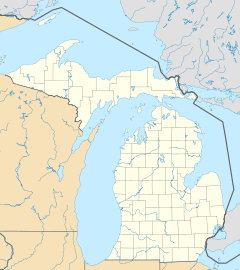Buchanan, Michigan facts for kids
Quick facts for kids
Buchanan, Michigan
|
|
|---|---|

|
|
| Motto(s):
"Life is better here."
|
|

Location within Berrien County
|
|
| Country | United States |
| State | Michigan |
| County | Berrien |
| Government | |
| • Type | City commission |
| Area | |
| • Total | 2.59 sq mi (6.71 km2) |
| • Land | 2.52 sq mi (6.53 km2) |
| • Water | 0.07 sq mi (0.18 km2) |
| Elevation | 696 ft (212 m) |
| Population
(2010)
|
|
| • Total | 4,456 |
| • Estimate
(2019)
|
4,263 |
| • Density | 1,690.33/sq mi (652.52/km2) |
| Time zone | UTC−5 (Eastern (EST)) |
| • Summer (DST) | UTC−4 (EDT) |
| ZIP code(s) |
49107
|
| Area code | 269 |
| FIPS code | 26-11400 |
| GNIS feature ID | 1618891 |
Buchanan is a city in Berrien County in the U.S. state of Michigan. The population was 4,456 at the 2010 census. The city is located at the southeast corner of Buchanan Township, about 5 miles (8 km) west of Niles.
Contents
History
The community was named after James Buchanan, the 15th President of the United States. Popularly known as "Redbud City" because of the many redbud trees that have historically lined city streets and the major approaches to the city, Buchanan has long been recognized as a Tree City USA by the National Arbor Day Foundation.
The St. Joseph River was once a major transportation route for Native American tribes in the area, especially the Potawatomi, and a historical marker to that effect has been placed on Moccasin Trail north of Buchanan near Batchelors Island.
The area was first settled in 1833 at the spot where McCoy Creek meets the St. Joseph River. The village of Buchanan was platted in 1842 and incorporated in 1858.
On April 12, 1979, farms, houses and mobile homes just north of the city were damaged by an F2 tornado. No lives were lost but several residences sustained significant damage.
Geography
According to the United States Census Bureau, the city has a total area of 2.57 square miles (6.66 km2), of which 2.50 square miles (6.47 km2) is land and 0.07 square miles (0.18 km2) is water.
Demographics
| Historical population | |||
|---|---|---|---|
| Census | Pop. | %± | |
| 1870 | 1,702 | — | |
| 1880 | 1,894 | 11.3% | |
| 1890 | 1,994 | 5.3% | |
| 1900 | 1,708 | −14.3% | |
| 1910 | 1,831 | 7.2% | |
| 1920 | 3,187 | 74.1% | |
| 1930 | 3,922 | 23.1% | |
| 1940 | 4,056 | 3.4% | |
| 1950 | 5,224 | 28.8% | |
| 1960 | 5,341 | 2.2% | |
| 1970 | 4,645 | −13.0% | |
| 1980 | 5,142 | 10.7% | |
| 1990 | 4,992 | −2.9% | |
| 2000 | 4,681 | −6.2% | |
| 2010 | 4,456 | −4.8% | |
| 2019 (est.) | 4,263 | −4.3% | |
| U.S. Decennial Census | |||
2010 census
As of the census of 2010, there were 4,456 people, 1,901 households, and 1,136 families residing in the city. The population density was 1,782.4 inhabitants per square mile (688.2/km2). There were 2,139 housing units at an average density of 855.6 per square mile (330.3/km2). The racial makeup of the city was 86.6% White, 7.5% African American, 1.2% Native American, 0.3% Asian, 1.3% from other races, and 3.1% from two or more races. Hispanic or Latino of any race were 3.3% of the population.
There were 1,901 households, of which 31.5% had children under the age of 18 living with them, 40.1% were married couples living together, 13.3% had a female householder with no husband present, 6.4% had a male householder with no wife present, and 40.2% were non-families. 34.8% of all households were made up of individuals, and 14.9% had someone living alone who was 65 years of age or older. The average household size was 2.34 and the average family size was 3.01.
The median age in the city was 37.6 years. 24.6% of residents were under the age of 18; 9.3% were between the ages of 18 and 24; 26.3% were from 25 to 44; 25.6% were from 45 to 64; and 14.3% were 65 years of age or older. The gender makeup of the city was 48.1% male and 51.9% female.
Arts and culture
Attractions
Pears Mill, a flour mill using the water power of the swiftly flowing McCoy Creek, was built in 1857 and still stands. It is open during the summer for visitors.
The Tin Shop Theatre, located near Pears Mill, is a small theater with performances in the summer. The seasons run into September and a variety of shows for everyone of any age and any occasion are performed there.
Many other attractions are located in surrounding Buchanan Township.
Economy
Buchanan was historically known as the headquarters for Clark Equipment Company, a manufacturer of truck axles, fork lift trucks, front-end loaders, and other heavy machinery. The company was formed in 1916 out of an acquisition of two other Buchanan companies. Clark left the area in the 1990s, forcing the city to diversify, and a number of smaller businesses took over the buildings Clark essentially donated to the city.
Electro-Voice, a manufacturer of high quality audio equipment such as microphones, amplifiers and loudspeakers, was also headquartered in Buchanan.
Education
Buchanan Community Schools consists of two elementary schools, Ottawa and Moccasin (grades K-4), Buchanan Middle School (grades 5-7), and Buchanan High School.
Infrastructure
Transportation
Buchanan is located 1.5 miles (2.4 km) north of US 12, 2.3 miles (3.7 km) west of US 31, 9.3 miles (15.0 km) north of the US 31 interchange on the Indiana Toll Road (I-80|I-90), and 20 miles (32.2 km) east of I-94 (exit 4 via US 12).
The nearest rail hubs are the Amtrak stations at Niles and New Buffalo, and the South Shore Line station in South Bend, Indiana.
Commercial air service is provided by the South Bend International Airport, with flights to larger hubs such as Atlanta, Chicago O’Hare, Cincinnati, Cleveland, Detroit, Las Vegas, Minneapolis-St. Paul, Orlando, and St. Petersburg-Clearwater.
Notable people
- Peggy Cramer, All-American Girls Professional Baseball League player, born in Buchanan
- Virgil Exner, influential automobile designer, lived in Buchanan during his youth and graduated from Buchanan High School
- John Grant, singer-songwriter born in Buchanan
- Jack "Sky" Knight, aviation pioneer
- Cary Moon, urban planner and politician
- Harry Niles, outfielder and second baseman for St. Louis Browns, New York Highlanders, Boston Red Sox, and Cleveland Naps; born in Buchanan
- Jackson Scholz, the 200-m sprint champion in the 1924 Olympics (portrayed in the film Chariots of Fire), also a successful author; born in Buchanan
- Jay Town, United States District Attorney, raised in Buchanan and graduated from Buchanan High School
- Hannah Roberts, (BMX cyclist) born in Buchanan
See also
 In Spanish: Buchanan (Míchigan) para niños
In Spanish: Buchanan (Míchigan) para niños


